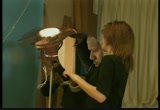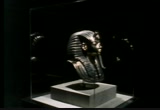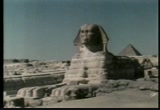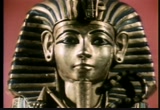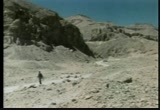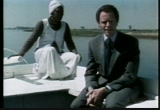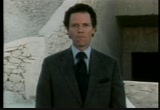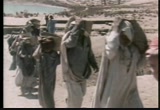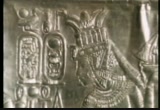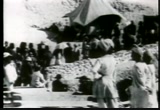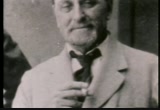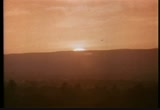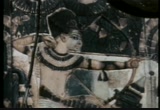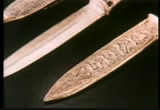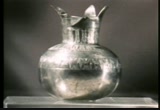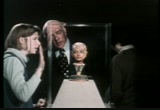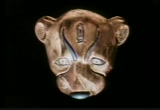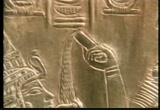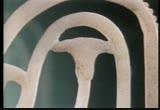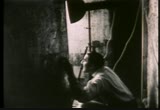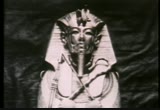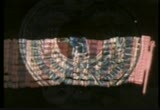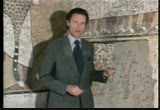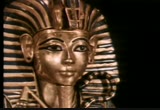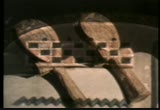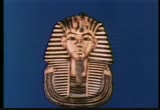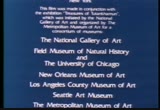tv Deutsche Welle Journal LINKTV September 18, 2012 11:00am-11:30am PDT
11:00 am
11:01 am
11:02 am
the mightiest empire of the ancient world. he was a god. nothing was beyond his means. when tutankhamun sat upon his throne, thousands of years of history and achievement had already preceded him. surely a nation that could bring itself into being and create wonders like the great pyramids could overcome man's final enemy--death. and overcome death tutankhamun has--at least according to the ancient egyptian funerary beliefs, for the very act of speaking his name provides magic to infuse tutankhamun with everlasting life. names were important to the egyptians.
11:03 am
a name symbolized one's personality and even one's very existence. to remember the dead was to make them live again. and so tutankhamun must, for the whole world has known his name ever since that day in november of 1922, when archeologist howard carter anhis patron, lord carnarvon, turned a forgotten pharaoh into a legend. the story of tutankhamun's treasures begins here in the secret valley of the kings in egypt, across the river from the ancient capital of thebes. the valley of the kings is hot and very dry. in the summer, the temperature can go up to 120 degrees. it would be a terrible place to live, but what a marvelous place to keep things for eternity.
11:04 am
pharaohs' tombs, equipped with all the necessities for a voyage into eternity, were hidden here. this is hundreds of miles from the great pyramids. the problem with the pyramids was that they were too conspicuous to robbers. in this valley, the idea was that no one would know. this fascination with the afterlife, and the state of mind of the ancient egyptians in general, can be best understood by learning something about their environment-- which basically means... the river nile. all activity centered on its water and its fertile banks.
11:05 am
( sheep and goats bleating ) the desert, literally a footstep away, was a constant reminder to the egyptians that, without the nile, there would be no life. the nile offered ancient egypt more than just its life-giving water or the transportation lifeline that unified an empire. it offered the gift of renewal. every year about july, the floodwaters of the nile would gradually rise, carrying fertile silt down from the headwaters until the farmland had been renewed as the floodwars receded. not surprisingly, the ancient egyptians living with this cycle soon came to equate the regular pattern of the nile and its gift of rebirth with the universe itself.
11:06 am
their most important philosophical principles stemmed from that equation. it was the idea of maat-- roughly "rightness" or "order." everything about the egyptian way of life had a pattern, a rhythm, a sense of orderly beginning and end. so too, the egyptians believed, this must be the way of man. man's end on earth was merely a beginning in the next world. when a pharaoh asked, "how long is life?" he was told, "thou art destined for millions of years, for a lifetime of millions." ( ship's horn blowing ) when howard carter returned to the valley of the kings from england in 1922, it was his last chance to find the elusive tomb of the pharaoh tutankhamun. for six years he had searched, but now his support from his sponsor, lord carnarvon, was almost exhausted.
11:07 am
each morning, carter rode into the valley-- as trists still do--and continued his work undaunted. the search, as always, had to be done slowly and painstakingly by hand, the tons of earth and stone mod by small baskets. then, five days after the beginning of the season's dig, the work stopped. howard carter recounted e story in his book the tomb of tutankhamun: howard carter: "hardly had i arrived on the work "than i was greeted by the announcement "that a step cut in the rock had been discovered." brown: but what had carter found? just another emptyomb? some unimportant storeroom? howa carter: "with trembling hands,madeh
11:08 am
"in the upper left-hand corner of the doorway. "as my eyes grew accustomed to the light, "details of the room within emerged slowly from the mist. "surely, never before in the whole history of excavation "had such an amazing sight been seen "as the light of our torch revealed to us: "strange animals, statues, and gold. "everywhere the glint of gold. "we had seen enough. "we reclosed the hole, mounted our donkeys, "and rode home down the valley, strangely silent and subdued." brown: the discovery of tutankhamun's tomb in 1922
11:09 am
had an instantaneous and shattering effect on the world's imagination that continues to this very day. extraordinary numbers of visitors descended upon the tomb--sometimes to the point where the excavators were unable to function. egyptian motifs swept through the world of fashion and design. as the whole worldthrilled, death and the supernatural seemed to gin to prey upon the excavators. lord carnarvon died rst--from the bite of a mere mosquito.
11:10 am
as death closed over him in april of 1923, only a few months after the opening of the tomb, the lights of cairo extinguished with him. stranger still, at the same instant in england, s dog gave a terrifying howl and died. then georges benedite, the head of egyptian antiquities at the louvre museum, died of a stroke after leaving a tomb. still another death occurred-- that of arthur c. mace from the metropolitan museum in new york, who was assisting carter. the bizarre events surrounding the opening of tutankhamun's tomb appear today to have been merely coincidental. the unextinguishable legend of the mummy's curse had begun. who was this king? what was he like?
11:11 am
what did he achieve in a life lived 34 centuries ago? we don't know for sure. all we have are images. even with its discovery, the tomb still refuses to yield many of its secrets. we know only that the young boy king, tutankhamun, grew up during one of the most turbulent periods in egypt's long history. it was a time when the stability of egypt had been wracked by a religious and political revolution that for the first time in history eliminated all gods but one: aten, the sun. the precipitator of the crisis was the pharaoh akhenaten, in whose court tutankhamun was raised. akhenaten was a strong-willed genius who has been called the first true individual in history. rather than portraying himself as the all-conquering pharaoh
11:12 am
as egypt'sings had done for 1,700 years before, akhenaten revealed himself in human terms, with his family gathered about him. inead of wshipping the enormous and confusing gaxy of egyptian gods in their human and animal form, aknaten swept them all ide to make the sun, with its life-giving rays, the symbol of his universe. the shock of such determined and rapid change to a system that had always been extraordinarily conservative was just too much. egypt shook.
11:13 am
while tutankhamun's predecessor was creating a terrifying political and religious situation on the one hand, on the other he was able to infuse egyptian art with a revolutionary human warmth. akhenaten's ideas were strong enough to echo down through the next few kings. tutankhamun's reign, shortly thereafter, was to bear witness to this great flowering of artistic achievement. while there were many tombs larger than his, filled with vast arrays of objects, it has been argued that no tomb--other than akhenaten's-- would have contained objects of a higher creative quality than tutankhamun's. howard carter had this to say about the art found in tutankhamun's tomb: howard carter: "among the immense quantities of material
11:14 am
"in tutankhamun's tomb-- as also exhibited "in the beautiful reliefs of his reign "in the great colonnade of the temple of luxor-- "we find extreme delicacy of style, "together with character of the utmost refinement. "in the case of a painted scene, vase, or statue, "the primary idea of art is obvious. "but in utilitarian objects,rt-- "as we know too well today-- is not a necessity. "here in this tomb, the artistic value "seems to have been always the first consideration. "what are the great qualities of egyptian art? "they are the sense of pure feeling "that creates an element of serene dignity-- "and herein lies its supreme essence-- "and the extraordinary degree of truth, form, and character "portrayed within such absolute simple and minimum line
11:15 am
"by which it stands alone." brown: egyptian art was not immune to outside influence. in the shape of a pomegranate, this vase is witness to egypt's absorptive power. for one thing, silver was extremely rare in egypt. but for another, more importantly, pomegranates were not native to egypt at all, but to western asia. the egyptians adopted foreign designs and styles of workmanship and applied them to their own needs. whatever the sources of egypt's art, the results continue to this day to fascinate travelers and museum visitors around the world. the archaeologists began their search for the pharaoh here. where i'm standing, they found a flight of stone steps leading down to a sealed doorway. in the plaster were the seals
11:16 am
of the ancient neopolis officials. inside the doorway they found this sloping passageway filled from top to bottom with stones and rubble. clearing this took time because, mixed in with all the filling, were numerous objects. one of these was the head of tutankhamun as a young child. this rather extraordinary sculpture has a very specific purpose and meaning. tutankhamun is seen emerging from a blue lotus, just as the sun god did at the moment of the earth's creation. through this recreation, tutankhamun, too, would be able to be reborn as the sun god every day throughout eternity. when a second sealed doorway at the end of the passageway was removed, the archaeologists finally gained entrance to the actual tomb. this first room they called the "antechamber."
11:17 am
it was crammed with objects. their minds could barely cope with the profusion. just inside the door, where m standing, the archaeologists found a cup abandoned by some rather unsuccessful tomb robbers back in the days of the pharaohs. the cup is carved from one piece of alabaster and takes the shape of a white lotus. carter called this "the wishing cup," for the chalice carried an inscription that was the essence of the tomb's intention. it says, "may you spend millions of years, you who love thebes, sitting with your face
11:18 am
to the north wind, your two eyes beholding happiness." on top of a large couch in the room stood a beautiful storage chest. inside the box was found a leopard's head made of wood covered with gesso and then overlaid with gold. quartz eyes give it a haunting, realistic touch, and the details are made with colored glass. tutankhamun's throne name, nebkheperure, is emblazoned on the leopard's forehead. the head belonged to a leopard-skin mantle being worn here in the tomb by ay, who took over as chief priest in the burialeremony known as "the opening of the mouth." ay then took over as pharaoh. gold was used liberally in the tombs of egypt. as a wealthy nation, she could afford the use of the metal, but, more than that, gold was used in the belief
11:19 am
that its immutability could be transferred to the deceased. this shrine, also found in the antechamber, is wood covered with a layer of gesso and then overlaid with sheet gold. the scenes on its sides are hily reminiscent akhenaten's period, with wa family groupings which convey aense of true emotion rarely evident in the more stylized art of other periods. between two of the animal-form beds was found a cache of alabaster vases. almost all of them had had their contents of unguents removed by thieves. precious oils must have been extremely valuable in tutankhamun's time, inasmuch as the tomb robbers choose them over many other objects in the tomb.
11:20 am
this vase is impressive for its carving, but it is also interesting for its symbolic reference to the unification of egypt. at one time, egypt was two countries: the delta area called lower egypt and the southern region called upper egypt. when the two countries were united in 3100 b.c., the concept of unification became a theme, which continued throughout egypt's long history. tied together, symbolizing unity, are the lotus of upper egypt and the papyrus of lower egypt. it took the archaeologists seven weeks to clear this antechamber. now they were ready to open a third sealed door in their search for the pharaoh. carter and carnarvon had no idea of what to expect when they broke down the doorway. what they saw was beyond their imagination. it looked like a solid wall of gold before them.
11:21 am
as the wall came more into view, they discovered it was, in fact, an enormous golden shrine. this might be what they were oking for. they entered the room, and their hearts sank. there was no seal on the door to the shrine. but then, when the door was opened, their spirits soared. the door to the second shrine was sealed with a mark of the necropolis officials. they had found their king. the shrine turned out to be not one shrine, but a whole series of shrines, one inside the other. it took carter two years' more work to reach the pharaoh at last.
11:22 am
11:23 am
as he is to us. tutankhamun's dy was found covered with jewelry. aesthetically, many of the pieces are rare treasures in and of themselves. t jewelry had a greater purpose in ancient egypt. bracelets, rings, and necklaces served as amulets to protect and aid both the living and the dead in their journey through this and the next life.
11:24 am
next to the burial chamber here was an open doorway to a room that howard carter came to call "the treasury." and an apt name it w because it contained some of the most extraordinary objects imaginable. the foremost object to catch carter's eye was a great shrine six feet tall surrounded by four beautiful goddesses. these goddesses were protecting the dead king's viscera, which were preserved separately during mummification. extremely elegant in form, the carved-wood figures
11:25 am
were first covered with gesso and then gilded. on their head is placed the hieroglyphic symbol representative of each goddess. in this case, we see selket with her symbol and ally, the deadly scorpion. inside the great shrine, protected by selket and the other goddesses, were four small mummiform cases containing the pharaoh's internal organs. intricately inlaid on the outside with color glass and carnelian, the inside as well was finished with chased gold designs and inscriptions. another remarkable sculpture from the treasury is the pharaoh tutankhamun harpooning. ordinarily, egyptian sculpture in the round rarely portrays a king or queen in motion. this piece does so with incredible realism-- a style previously believed to have originated only with the coming of the ancient greeks.
11:26 am
the treasury was filled with objects both magical and beauful. there were miniature boats, statues of gods, servants who would come to life to serve the king, and personal articles like mirror cases. there was even a box in the shape of tutankhamun's name. the oval shape enclosing the king's name was a symbol reserved for royalty. it is actually a loop of rope tied at one end and means that the pharaoh was lord of all the sun encircled. how does one put into perspective a civilization that was most ancienyet extraordinarily sophisticated and able to maintain itself over a span of 3,000 years?
11:27 am
french art historian elie faure suggests that ancient egypt, through the solidarity, the unity, and disciplined variety of its artistic products, through the enormous duration and sustained power of its efforts, offers the spectacle of the greatest civilization that has yet appeared on the earth. who can say? in any case, the artistry that has come down to us speaks for itself.
203 Views
IN COLLECTIONS
LinkTV Television Archive
Television Archive  Television Archive News Search Service
Television Archive News Search Service 
Uploaded by TV Archive on

 Live Music Archive
Live Music Archive Librivox Free Audio
Librivox Free Audio Metropolitan Museum
Metropolitan Museum Cleveland Museum of Art
Cleveland Museum of Art Internet Arcade
Internet Arcade Console Living Room
Console Living Room Books to Borrow
Books to Borrow Open Library
Open Library TV News
TV News Understanding 9/11
Understanding 9/11